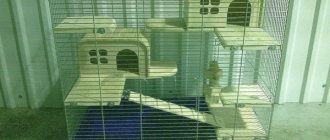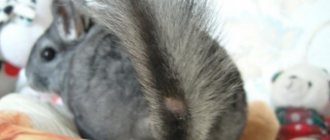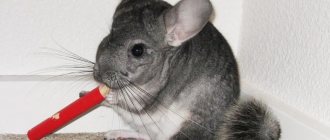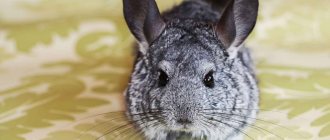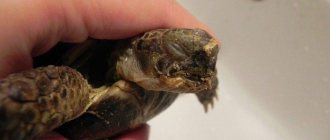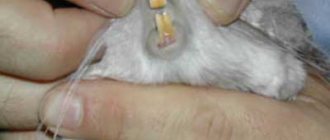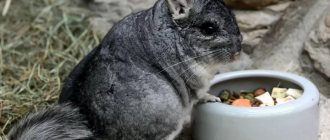- home
- Chinchilla
- Nutrition
04/02/2019 Air, drink and food are the most important conditions for the survival of most creatures living on Earth. Moreover, they can all go without food or drink for some time.
How difficult is it to keep chinchillas at home?
The animal will happily live in the cage if it is large enough. Chinchillas are very active. They run a lot and jump often. A house for a mobile rodent measuring 110x90x50 will be just right.
During daylight hours, chinchillas love to sleep. And by nightfall they begin to show interest in food, owners, and the environment. The favorite pastime of these animals is to stir things up. For this reason, various rustling noises are often heard in the house. But lovers of cute rodents quickly get used to such a background and stop reacting to it.
Silence is the key to health
Although these small animals are very noisy, they cannot tolerate loud outside sounds. Therefore, do not place the cage near the TV and try not to frighten the animal with screams and knocks. Such stress can lead an animal to heart failure. Therefore, when experts are asked: “How long does a chinchilla live?” - they can only throw up their hands and say that her life is in your hands. Protect the animal from shocks, and it will delight you with its presence in the house for many years.
Drafts are also unacceptable for their fragile organism. The temperature in the house should not be lower than 21 degrees. Otherwise, the pet may fall ill from hypothermia. Then long and expensive treatment will be required. These are such amazing animals, their fur is considered the warmest. After all, there are more than a thousand “fluffs” in one bulb. Owners of these small rodents will never be able to wear a fur coat from their counterparts. After all, once you look into the eyes of this animal, you will fall in love with it!
Be sure to make yourself such a beautiful and loyal friend. It is better to go for an animal to experienced breeders. They will explain the details of keeping the animal, and you will receive only positive things from communicating with it. Now you know how long a chinchilla lives. And by following all the rules of care and maintenance, you will live side by side with your pet for half its life.
What to feed the animals
Proper care of a chinchilla at home involves proper and balanced nutrition. This type of rodent belongs to the family of herbivores. Specialized food is used when living at home. A chinchilla's house should always have hay and fresh water. Animals are always not averse to eating. To get a “yummy” - a nut, a seed or a raisin, they can depict touching scenes. But you have to be careful with this. This kind of food is not for chinchillas. A delicacy that is beneficial for their health and appearance is a slice of dried apple, a piece of carrot, or hawthorn.
Molars in rodents will continue to grow throughout their lives. To wear them down, buy your pet a salt mineral stone. By the way, the chinchilla receives beneficial substances from the stone. In the spring-summer season, you can give the rodent dried branches of apple and birch trees.
How does childbirth proceed in chinchillas?
Before giving birth (2-3 days before), the females remove the bathing suit with sand from the cage, and the nesting house is turned over with the hole facing up. In this position of the house, the female will not be able to throw out of it the material laid there for insulation (hay or straw is usually placed as bedding). 3-6 days after birth, the nest box is turned with the entrance to the side so that the puppies can freely crawl out of it. In cool weather In weather conditions, it is advisable to heat the nest using an electric heater. Such measures will contribute to the normal course of labor and help maintain the health of the female. Before giving birth, the female chinchilla makes a nest for herself in the nesting house. She begins to crush the bedding with her teeth, puts it in a heap, and begins to pluck out her fluff in the belly and chest area. All down plucked by the female should be left in the nest. It happens that a chinchilla does not build a nest for itself, then the owner needs to make it himself from hay and line it with down. As the birth approaches, the female moves little and often lies on her side. During the prenatal period, the animal reacts with increased anxiety to extraneous noises, sudden movements of an approaching person, and flashes of light. It is better not to disturb a pregnant chinchilla again, as its stressful state can be very dangerous in the future. A disturbed female is quite capable of killing or eating her cubs. In order to protect the female from unnecessary worries, the nest is covered with a dark cloth.
During this period it is necessary to handle it with extreme care and caution. When a chinchilla is pregnant and the time is approaching childbirth, the animal should not be picked up
If it is necessary to better show the animal to a veterinarian, pick it up carefully, supporting the belly with your hand from below. In a cage where a pregnant female lives, the bedding needs to be changed more often. It is ideal if the bedding is good wood filler or dry and fresh finely stemmed hay with low thermal conductivity. This bedding retains heat for a long time, so it is of particular value in the cold season. There should be fresh water in the chinchilla cage at all times. The female gives birth between 5-8 am. After giving birth, she can be given sugar, not in large quantities up to 2 grams. The female feeds the puppies with milk, which appears within 24 hours after birth. When examining, seeing that the puppies are “sitting” hunched over and squeaking loudly, you need to carefully and carefully examine the female herself and make sure that she has no milk - the puppies must be fed “artificially”. For this purpose, milk powder is diluted 1:2, condensed or concentrated milk is diluted in the same proportion. Cow's milk and goat's milk are suitable. For the first three days, puppies are fed eight times a day.
The female may become covered again with a male the very next day after giving birth.
Puppies are separated from the female even at one month of age, provided that they are fed boiled milk. But the chinchilla cage must be well insulated. As a rule, the released young animals are kept in spacious cages, several heads each, females and males are separated. And they can live together for up to five months.
With annual counting and analysis, there are usually 5-10% more boys born than girls.
For further breeding, active, strong, good physique and high-quality hair are left. Preferably from fertile parents.
In general, there are no problems with these animals. The female chinchilla is a very caring and good mother!
What is the best microclimate to organize for rodents in an apartment?
It is very important to have air conditioning in your home if you live in hot climates. High temperatures have a detrimental effect on chinchillas. In this regard, caring for a chinchilla at home presents some difficulties. The best temperature parameter for animals is +17, +22° Celsius. The minimum temperature should not fall below 14°, and the maximum should not rise above 28°. But this high should not last long. At a room temperature of about 29-30°, the chinchilla quickly dies due to heat stroke.
Prolonged exposure to sunlight has a negative effect on the health of rodents. Sunbathing can be done for pets for 10-15 minutes during the daytime. In case of heat stroke, the animal should be cooled using a container of frozen or very cool water. Chinchillas also do not like drafts. So it is better to install the cage in places that are safe in this regard.
Chinchillas do not tolerate loud noise well, so home care also includes limiting the strength of the background sound. Animals are easily frightened by sharp, loud sounds, but they can get used to TV shows and keep you company while watching. But ideally, the best conditions are peace and quiet.
Sweet home
It is better to choose a spacious cage for your pet. It would be good if it had a small house, a closed compartment. Chinchillas love privacy. Individuals are found to be very active, they rush around the cage day and night, sleeping only a few hours a day. But it happens the other way around, the animal is lethargic and constantly dozes. Just like humans, they have character and temperament, so watching them is a pleasure.
With proper animal care, you will not have to worry about how long your pet chinchilla lives. The bottom of the cage should be dry and strewn with sawdust or special filler. Paws should not step on moisture. This animal even bathes in the sand. Water is unacceptable to them. The fluffies drink from special sippy cups that hang on the wall.
What do pets get sick of?
Most often, in captivity, chinchillas suffer from dental problems (overgrown hooks) and disorders of the gastrointestinal tract (inflammatory processes in the intestines, diarrhea, food obstruction).
But even an inexperienced person can recognize such diseases. And if the owner takes the necessary measures in time, the rodent’s health will quickly recover.
No vaccinations are provided for rodents living in human homes. They still receive preventive vaccination against dermatitis in the nursery. Proper care and feeding is the key to a painless existence for your pet.
Chinchilla cat standard
Chinchillas are solid and stocky cats. Their image is enhanced by their thick, dense coat, which gives their body a pleasant softness and roundness. Chinchilla cats are noticeably smaller than males, so the latter are always more popular among lovers of textured pets.
The chinchilla color is documented for representatives of three breeds:
- Persian;
- British (short-haired and long-haired);
- Scottish (straight and fold).
Individuals belonging to the Persian clan have longer fur and have super fluffy tails, the hair on which can be twice as long as on the body. The body standard of Persian chinchillas is the same as that of their eastern counterparts, but with minor additions. In particular, the noses of representatives of the first variety are not so short, so the problems of difficulty breathing, characteristic of brachycephalic breeds, are inherent to them to a lesser extent.
British chinchillas are large pets with round heads and chubby cheeks. Their eyes are wide apart, their ears are small with rounded tips, their noses are wide and short. Coat type: semi-long or short. In fact, all representatives of this branch differ from the traditional British only in color. All other characteristics are inherited by pets from their relatives in full. Typically, representatives of this type of chinchilla are silver or golden in color, but the latter option is less common.
Scottish “mix” chinchillas fully fit into the standard of Scottish folds and straights: the same slender legs, muscular body and raised pads on the face. The animals' fur is silver or peach with darkened tips. The hair itself is dense, short, but without a pronounced fit to the body. Acceptable iris colors for Scottish chinchillas are green and blue.
Where to buy a chinchilla
It is highly not recommended to purchase animals at markets. Firstly, by doing this you support the illegal import of rodents. Secondly, market traders and transporters do not care at all about the standards for keeping animals, which is why they often get sick and quickly die.
To purchase a known healthy animal, look for experienced breeders or officially operating nurseries. In this case, the owner will tell you about the pet’s age and its taste preferences. The fact is that chinchillas have a “weak” stomach. And a sudden change in food causes them diarrhea (the animals curl up their ears and lose activity). It is necessary to transfer the rodent to another food in stages.
How to choose a chinchilla: a pet with character
So, if you decide to get this cute creature, then when visiting a chinchilla breeder, pay attention to the behavior of the animals when the owner approaches the cages or opens the doors. Keep in mind that each animal has its own unique character.
Some of the chinchillas run up to the open door with curiosity and even try to take advantage of the opportunity to get out. These are definitely leaders. They are not only the most active, but also the most restless, and at the same time, the most interesting animals. Communication with them will bring a lot of pleasure and positivity, especially to children.
There is also a type of animal that, when the cage is open, is not in a hurry to leave it, but first tries to find out for what purpose it was opened: whether they want to feed them, offer them a walk, or want to transplant them into another cage. This category of chinchillas has a calm character and balanced temperament. It is good to form long-term pairs from such animals, when the female and the male constantly live together and take care of the offspring.
But there are also chinchillas who either show virtually no reaction when the door is opened, or even try to hide in the farthest corner of the cage. Similar behavior is observed when kept in groups, and these animals are in a depressed state. If you do choose such an animal, then, to be honest, its character is difficult to predict. If the animal is already an adult, it may become withdrawn and avoid contact with humans. If he is still a baby, then perhaps he will grow up to be a cheerful and sociable pet. But if your animal still turns out to be too closed, then in the end, establishing friendly contact with it will depend only on your patience and the time you devote to it.
So, we have decided on the character of the animal. But besides this, we need, of course, a healthy animal.
For what reasons does a chinchilla not drink water from a drinking bowl?
Any changes in living conditions and environment cause a stress reaction in the animal. A new partner, a change of cage or place, or a noisy environment can cause a rodent to refuse food and drink. Some expert recommendations for such situations:
- When it is definitely established that the animal has not used the drinking bowl for more than a day, you can try giving water in another container - a spoon, bowl, or the owner’s palm.
- If the rodent still refuses, it is advised to give it something to drink from a syringe. You just have to remember that this is a lot of stress for the animal. You can resort to this method only as a last resort, for example, if your pet is constipated.
- A dried apple that you can offer to your chinchilla will give the body some moisture. Having calmed down, she will return to the drinking bowl.
- If the animal has previously been given water from a saucer or bowl, you should simply accustom it to the new device. Usually it is enough to show how the device works, and the chinchilla begins to use it.
If the animal behaves as usual, is active, eats well and sleeps, it means that the owner simply does not notice when his pet drinks or the rodent gets enough moisture from the food it eats. In any case, there is no reason to worry.
Source
What to do if your pet doesn't drink?
Chinchillas are very psychologically vulnerable animals, naturally prone to stress with any changes in their lives. A banal noisy holiday in the family, a new cage, and even more so a new habitat for a pet can throw it out of balance and lead to a refusal to both drink and eat. The animal perceives all these factors as stress.
Experienced owners recommend in such cases:
- Make sure that the pet has not drunk water for 24 hours (measure the volume as described earlier);
- Offer the chinchilla some water from a spoon;
- Give the animal an apple: the liquid from the pulp will enter the body with the fruit.
Some owners suggest force-feeding from a syringe if the rodent refuses to drink from a spoon. But since this can cause even more stress for the animal, we will postpone this option for emergency cases.
If you are sure that the pet is not experiencing a stressful situation, but is simply still too small (or has previously been given water from a bowl), you should accustom the chinchilla to a drinking bowl. You will need to pick up the water bowl and wait for some time. When you see that the chinchilla is looking for a source of water, then you should show your pet exactly how the drinking bowl works. Make water drip out of it. Chinchillas quickly understand how to use this device.
Water for a chinchilla: how much should a chinchilla drink, possible reasons for refusing water
Chinchillas have an unusually good appetite - they eat something most of the time, digging in the hay to find the most tasty morsel.
A healthy pet is always happy with the treat offered. But there are times when an animal stops not only eating, even drinking; becomes lethargic and may begin to lose weight. As a rule, these are signs that indicate the presence of diseases. The rules of nutrition and drinking regime are what you need to pay attention to when keeping any pet in the first place. All rodents in the cage must have access to drinking water. This can be either a drinking bowl or a bowl (less often), the main thing is that the animal always has the opportunity to quench its thirst with fresh water. The average water consumption per rodent is from 10 to 40 ml per day. Baby chinchillas drink very little. You may not even notice how much the amount of water in the drinking bowl has decreased. This often misleads the owners that the animal does not drink at all, and at the same time is absolutely healthy.
Sedentary chinchillas drink less than their more active counterparts. Sick Rodents also often refuse water or drink less than usual. In a well-heated apartment and in the warm season (summer), a chinchilla drinks a lot of water; in a cool room (or, for example, in winter) - less.
Finding out exactly how much your animal drinks is very simple - to do this, put a mark on the drinking bowl when it was first filled and check how much is left after a day. It makes no sense to track the amount of water during the day, since chinchillas (like most rodents) are nocturnal animals and eat and drink mostly at night.
Vitamins
Contrary to popular belief, there is no need for additional vitamins. If a chinchilla's diet is complete and varied, it contains a lot of succulent food, as well as high-quality granulated food, then the animal is unlikely to have a deficiency of any vitamin.
The list of things you can feed a chinchilla is quite large and creating a full menu for your pet will not be difficult. Another important point is that all vitamins are of chemical origin and still belong to medicines. Therefore, it is better not to add them to food unless necessary. The exceptions are animals that are preparing for an exhibition, pregnant and lactating females, as well as those recovering from illness.
Is it expensive to keep a chinchilla?
Details Parent category: Rodents Category: Chinchillas Published 09/28/2015 20:16
How much does it cost to keep a chinchilla?
In recent years, the demand for unusual pets has increased. For example, many would not refuse to have a chinchilla as a pet. However, not everyone understands how much money is required to maintain an animal.
If you're lucky, the animal may come into your home as a furry gift, but its maintenance, treatment and preventive measures, food selection and other responsibilities will fall entirely on your shoulders.
A cage or display case will require significant financial expenses. A chinchilla needs a spacious, good quality and large cage, and this costs approximately 7,000-10,000 rubles. However, it should be noted that the cage has many disadvantages. Very soon, the garbage flying out of it and the constant noise will begin to get on your nerves, and you will think about a display case. You can build it yourself, which will significantly save money. Or you can order the production of a display case, then, based on the quality of the material and size, the price will vary between 5,000-60,000 rubles.
A house should be placed in the middle of the display case or cage. You immediately need to decide on high-quality material, and not cheap plywood, which the animal will chew off in a couple of weeks and then you will have to buy a house again. You will have to spend about 1,500 rubles on a house for a chinchilla.
In addition to a display case or cage, the animal needs special food and complementary foods. The food is desirable from European producers, but the rodent eats modestly, so it will “eat up” the owner for about 1000-1500 rubles a month.
Pebbles are needed to grind teeth. Their size and quantity used depend on the rodent. This can cost 300-500 rubles. The price of toilet equipment can reach 500-700 rubles; The filler costs about the same. You can use sawdust and save several hundred. Glass baking trays are often used for toilet trays: this is both safer for the animal, which is partial to gnawing on plastic, and cheaper, since it will last much longer.
The chinchilla's place of residence must be equipped with a feeding trough, drinking bowl, and hay barn. The price of such a set reaches 2500 rubles.
You should not forget about entertainment for your favorite rodent. Various toys, tunnels, ladders, hammocks and other exciting devices will make the life of your ward much brighter, but you will also not get it for free, of course, unless you make them yourself from scrap materials.
Among other things, it should be taken into account that the animal may get sick and you will also have to fork out money for a visit to the veterinarian and medicines, but these are all everyday little things, because there is nothing you can do for the well-being of your beloved creature.
- < Back
- Forward >
What kind of water to give a chinchilla
In this matter, it is reasonable to focus on the animals’ natural habitat. There is no chlorinated (from the tap) or boiled water. Chlorinated water can cause diarrhea, boiled water can cause constipation. Fluoridated water, which is beneficial for humans, is also unsuitable for chinchillas.
The best drink for your pet is clean bottled water, filtered, well or spring. Tea, coffee and milk are harmful to chinchillas, which are absorbed by animals only up to 2 months of age.
Water filtered by reverse osmosis is harmful to the animal's body because it leaches out the minerals it needs. It can be used if you additionally install a mineralizer.
What does it take to get a chinchilla?
The opinion that it takes a lot of money to keep a chinchilla is based precisely on the arrangement of its home.
A chinchilla is less active than a cat or dog. Such an exotic rodent really needs significant finances. To begin with, you will have to purchase such mandatory things as:
- cage - from 5 thousand rubles;
- house - 500−700 rubles;
You cannot buy a cage that is too cheap and small - the chinchilla needs space. It's better to immediately take a display case. It is much more expensive, from 15 thousand rubles, but it will last longer and the pet will be more comfortable there.
Equipped area for chinchillas
- drinking bowl - 200−500 rubles;
- bowl - 100−350 rubles;
- bathing suit - 700−1500 rubles;
In addition to start-up costs, it is worth taking care of monthly supplies
It is important to provide the rodent with a complete and as varied diet as possible. And all kinds of wooden accessories will not only become an interesting leisure activity for the animal, but will also help grind down the rodent’s teeth:
- sand (change every 1-3 months) - 200-500 rubles;
- granules (1 kg of main feed) - 400−500 rubles.
- cereals, hay and drying - 300−700 rubles;
- filler (1−5 kg of wood) - 200−400 rubles;
- pieces of wood and pumice - from 100 rubles.
Buy only high-quality feed. Chinchillas cannot eat sweets, and most modern companies sell cheap but low-quality food. Sometimes it is safer to buy food from breeders.
Mother and child in a cage Among the optional but recommended things, it is also worth mentioning a carrier (800-1500 rubles), which can be used for a visit to the veterinarian and as a bathing suit, a hanging hammock for relaxation (600-00 rubles) and a container for filler ( 200−500 rub.).
How much water does a chinchilla drink per day?
There are no clear recommendations in this regard. For each individual, the norm is determined purely individually and depends on:
- on the animal’s well-being;
- his age;
- temperament and character;
- climate and weather conditions;
- season;
- feed composition;
- emotional state of the animal.
For example, chinchilla babies hardly need water during the feeding period. The liquid contained in mother's milk is enough for them. A nursing female drinks more than usual, which is natural in her position.
Adult rodents can drink less if they have enough moisture from juicy food - apples, pears, cucumbers, tomatoes, carrots, potatoes, greens.
Calm chinchillas, older individuals or sick rodents consume less fluid than temperamental, young and healthy animals.
In winter, autumn and spring, chinchillas drink less than in summer. Some owners note a decrease in their pets' appetite in hot weather, while they drink more water.
On average, an animal drinks from 10 to 40 ml of liquid per day. To know how much water your pet needs, make a mark on the drinking bowl. Check the remainder at the same time 24 hours later. Taking readings during the day will not give the correct result because the chinchilla is active at night, during which time it eats and drinks.
How chinchillas drink and how to train them to drink
On average, chinchillas drink 15-25 ml of water per day. The chinchilla needs to be accustomed to drinking water so that it independently drinks as much liquid as it needs. It is difficult to answer the question exactly how much a chinchilla drinks, because each individual and the conditions created by their owners are very different.
It’s okay if she drinks 10-20 ml more than normal, but it’s still better to find out the reasons. Chinchillas drink a lot of water when the room is very hot, usually in the summer. Some large individuals are able to drink 100 ml of water per day to help the body regulate its temperature. When a chinchilla drinks a lot, many puddles appear near the toilet, and the filler crumbles, turning into sawdust due to the large amount of moisture.
If the chinchilla drinks little or does not drink at all, then it means that it is sick, you need to look for other symptoms that can be used to make a diagnosis, or better yet, contact a veterinarian. Usually, when a chinchilla does not eat or drink, it becomes very lethargic and it is immediately obvious that it is sick.
What to feed your chinchilla?
Rodents should only be given water to drink. And, firstly, you need to understand that a chinchilla is a wild animal and boiled water is not suitable for it. Although some owners believe that you can even give your pet boiled water. It's a delusion. Secondly, although there are no microbes in boiled water, there are practically no useful substances there either.
The best water for a chinchilla is spring or well water. Bottled drinking or filtered water is also suitable. It is very important to realize that humans and rodents have completely different digestions and the need for micro and macroelements. Therefore, chinchillas should not be given fluoridated water under any circumstances.
Water purified by reverse osmosis must be additionally mineralized. To do this, an additional mineralizer is installed on the filter. If this is not done, then such drinking will harm the pet. Water purified in this way flushes out the minerals the rodent needs for proper functioning.
